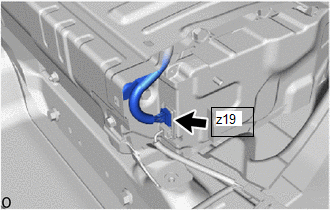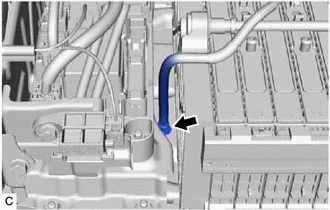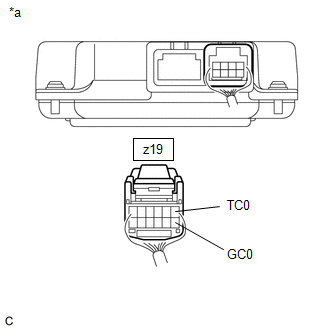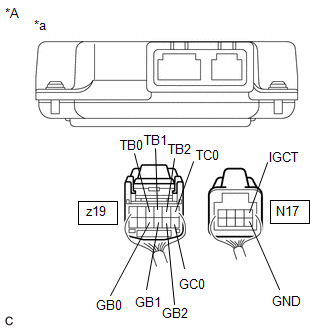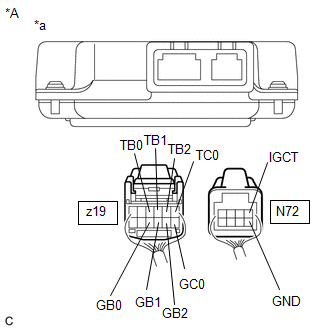| Last Modified: 01-30-2024 | 6.11:8.1.0 | Doc ID: RM100000001PEFM |
| Model Year Start: 2020 | Model: RAV4 HV | Prod Date Range: [06/2020 - ] |
| Title: HYBRID / BATTERY CONTROL: HYBRID CONTROL SYSTEM (for AWD with NICKEL METAL HYDRIDE BATTERY): P0AAC11,P0AAC15; Hybrid/EV Battery Air Temperature Sensor "A" Circuit Short to Ground; 2020 - 2024 MY RAV4 HV [06/2020 - ] | ||
|
DTC |
P0AAC11 |
Hybrid/EV Battery Air Temperature Sensor "A" Circuit Short to Ground |
|
DTC |
P0AAC15 |
Hybrid/EV Battery Air Temperature Sensor "A" Circuit Short to Auxiliary Battery or Open |
DESCRIPTION
The inlet air temperature sensor (battery) is mounted on the HV battery. The resistance of the sensor varies in accordance with changes in the intake air temperature. The characteristics of the inlet air temperature sensor are the same as those of the battery temperature sensors (Click here
![2019 - 2024 MY RAV4 HV [02/2019 - ]; HYBRID / BATTERY CONTROL: HYBRID CONTROL SYSTEM (for AWD with NICKEL METAL HYDRIDE BATTERY): P0A9B11,...,P0ACA15; Hybrid/EV Battery Temperature Sensor "A" Circuit Short to Ground+](/t3Portal/stylegraphics/info.gif) ). The battery voltage sensor uses signals from the inlet air temperature sensor to control the air volume of the battery cooling blower assembly.
). The battery voltage sensor uses signals from the inlet air temperature sensor to control the air volume of the battery cooling blower assembly.
|
DTC No. |
Detection Item |
DTC Detection Condition |
Trouble Area |
MIL |
Warning Indicate |
|---|---|---|---|---|---|
|
P0AAC11 |
Hybrid/EV Battery Air Temperature Sensor "A" Circuit Short to Ground |
The inlet air temperature sensor output voltage is lower than the specified value (short circuit) and the detected temperature is higher than the specified value. (1 trip detection logic) |
|
Does not come on |
Master Warning: Comes on |
|
P0AAC15 |
Hybrid/EV Battery Air Temperature Sensor "A" Circuit Short to Auxiliary Battery or Open |
The inlet air temperature sensor output voltage is higher than the standard value (short to +B or open) and the detected temperature is lower than the specified value. (1 trip detection logic) |
|
Does not come on |
Master Warning: Comes on |
HINT:
After checking for the above DTCs, check the hybrid system Data List item "Hybrid Battery Cooling Fan Intake Air Temperature 1" using the Techstream.
|
Displayed Temperature |
Malfunction |
|---|---|
|
-45°C (-49°F) or less |
Open or +B short circuit |
|
95°C (203°F) or more |
GND short |
Related Data List
|
DTC No. |
Data List |
|---|---|
|
P0AAC11 |
Hybrid Battery Cooling Fan Intake Air Temperature 1 |
|
P0AAC15 |
CONFIRMATION DRIVING PATTERN
HINT:
After repair has been completed, clear the DTC and then check that the vehicle has returned to normal by performing the following All Readiness check procedure.
- Connect the Techstream to the DLC3.
- Turn the ignition switch to ON and turn the Techstream on.
- Clear the DTCs (even if no DTCs are stored, perform the clear DTC procedure).
- Turn the ignition switch off and wait for 2 minutes or more.
- Turn the ignition switch to ON and turn the Techstream on.
- With ignition switch ON and wait for 5 seconds or more.
- Enter the following menus: Powertrain / Hybrid Control / Utility / All Readiness.
-
Check the DTC judgment result.
HINT:
- If the judgment result shows NORMAL, the system is normal.
- If the judgment result shows ABNORMAL, the system has a malfunction.
- If the judgment result shows INCOMPLETE, perform driving pattern again.
WIRING DIAGRAM
Refer to the wiring diagram for DTC P0A9B2A.
CAUTION / NOTICE / HINT
CAUTION:
-
Before the following operations are conducted, take precautions to prevent electric shock by turning the ignition switch off, wearing insulated gloves, and removing the service plug grip from HV battery.
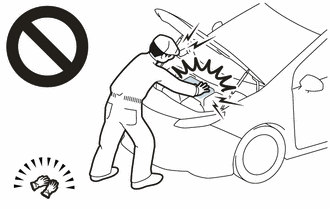
- Inspecting the high-voltage system
- Disconnecting the low voltage connector of the inverter with converter assembly
- Disconnecting the low voltage connector of the HV battery
-
To prevent electric shock, make sure to remove the service plug grip to cut off the high voltage circuit before servicing the vehicle.
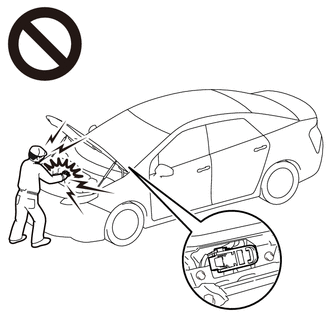
-
After removing the service plug grip from the HV battery, put it in your pocket to prevent other technicians from accidentally reconnecting it while you are working on the high-voltage system.
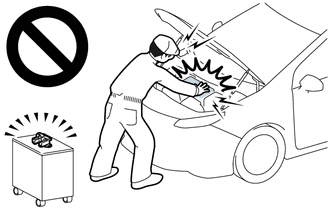
-
After removing the service plug grip, wait for at least 10 minutes before touching any of the high-voltage connectors or terminals. After waiting for 10 minutes, check the voltage at the terminals in the inspection point in the inverter with converter assembly. The voltage should be 0 V before beginning work.
HINT:
Waiting for at least 10 minutes is required to discharge the high-voltage capacitor inside the inverter with converter assembly.
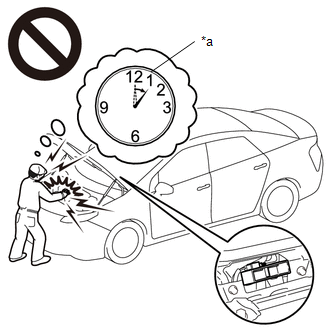
*a
Without waiting for 10 minutes
NOTICE:
After turning the ignition switch off, waiting time may be required before disconnecting the cable from the negative (-) auxiliary battery terminal. Therefore, make sure to read the disconnecting the cable from the negative (-) auxiliary battery terminal notices before proceeding with work.
PROCEDURE
|
1. |
CHECK DTC OUTPUT (HYBRID CONTROL) |
(a) Connect the Techstream to the DLC3.
(b) Turn the ignition switch to ON.
(c) Enter the following menus: Powertrain / Hybrid Control / Trouble Codes.
(d) Check for DTCs.
Powertrain > Hybrid Control > Trouble Codes
|
Result |
Proceed to |
|---|---|
|
"P0AFC00, P0AFC96 or P308A12" is not output. |
A |
|
"P0AFC00, P0AFC96 or P308A12" is also output. |
B |
(e) Turn the ignition switch off.
| B |

|
|
|
2. |
CHECK CONNECTOR CONNECTION CONDITION (INLET AIR TEMPERATURE SENSOR) |
CAUTION:
Be sure to wear insulated gloves.
(a) Check that the service plug grip is not installed.
NOTICE:
After removing the service plug grip, do not turn the ignition switch to ON (READY), unless instructed by the repair manual because this may cause a malfunction.
(b) Remove the No. 1 hybrid battery exhaust duct.
|
(c) Check the connections of the z19 battery voltage sensor connector. OK: The connector is connected securely and there are no contact problems. Result:
|
|
(d) Install the No. 1 hybrid battery exhaust duct.
| NG |

|
CONNECT SECURELY |
|
|
3. |
CHECK INSTALLATION OF INLET AIR TEMPERATURE SENSOR |
CAUTION:
Be sure to wear insulated gloves and protective goggles.
(a) Check that the service plug grip is not installed.
NOTICE:
After removing the service plug grip, do not turn the ignition switch to ON (READY), unless instructed by the repair manual because this may cause a malfunction.
(b) Remove the upper HV battery cover sub-assembly.
|
(c) Visually check the installation condition of the inlet air temperature sensor. Result:
|
|
(d) Install the upper HV battery cover sub-assembly.
| B |

|
| C |

|
INSTALL PARTS CORRECTLY |
|
|
4. |
CHECK HV BATTERY (INLET AIR TEMPERATURE SENSOR) |
CAUTION:
Be sure to wear insulated gloves.
(a) Check that the service plug grip is not installed.
NOTICE:
After removing the service plug grip, do not turn the ignition switch to ON (READY), unless instructed by the repair manual because this may cause a malfunction.
(b) Remove the No. 1 hybrid battery exhaust duct.
(c) Disconnect the z19 battery voltage sensor connector.
NOTICE:
Before disconnecting the connector, check that it is not loose or disconnected.
|
(d) Measure the resistance according to the value(s) in the table below. Standard Resistance:
NOTICE: When taking a measurement with a tester, do not apply excessive force to the tester probe to avoid damaging the holder. |
|
(e) Disconnect the N17*1, N72*2 battery voltage sensor connector.
- *1: for TMMC Made
- *2: for TMC Made
|
(f) for TMMC Made: Measure the resistance according to the value(s) in the table below. Standard Resistance:
|
|
|
(g) for TMC Made: Measure the resistance according to the value(s) in the table below. Standard Resistance:
|
|
(h) Reconnect the z19 and N17*1, N72*2 battery voltage sensor connectors.
- *1: for TMMC Made
- *2: for TMC Made
(i) Install the No. 1 hybrid battery exhaust duct.
| OK |

|
|
|
5. |
CHECK HARNESS AND CONNECTOR (BATTERY TEMPERATURE SENSOR AND INLET AIR TEMPERATURE SENSOR) |
CAUTION:
Be sure to wear insulated gloves and protective goggles.
(a) Check that the service plug grip is not installed.
NOTICE:
After removing the service plug grip, do not turn the ignition switch to ON (READY), unless instructed by the repair manual because this may cause a malfunction.
(b) Remove the upper HV battery cover sub-assembly.
(c) Check the wire harnesses and connectors of the battery temperature sensors and inlet air temperature sensor for abnormalities by sight and touch.
Specified Condition:
There are no open or short circuits in the wire harnesses and connectors. There are no short circuits to other wire harnesses.
(d) Install the upper HV battery cover sub-assembly.
| OK |

|
| NG |

|
REPAIR HARNESS OR CONNECTOR (INLET AIR TEMPERATURE SENSOR) |
|
|
|

